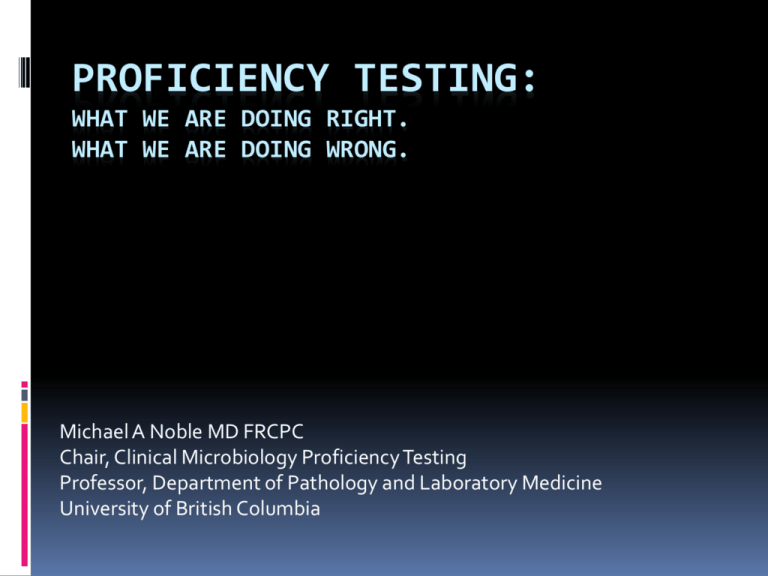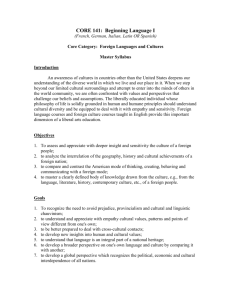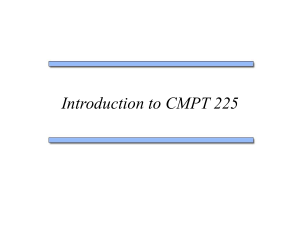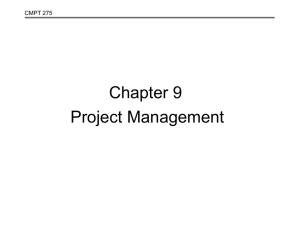Proficiency Testing
advertisement

PROFICIENCY TESTING: WHAT WE ARE DOING RIGHT. WHAT WE ARE DOING WRONG. Michael A Noble MD FRCPC Chair, Clinical Microbiology Proficiency Testing Professor, Department of Pathology and Laboratory Medicine University of British Columbia By way of introduction... CMPT Pathology and Laboratory Medicine University of British Columbia Began 1983 Annually Certified ISO9001:2000 Meet Requirements of ISO Guide 43-1:1999 By way of introduction... Clinical Bacteriology M y c o l o g y P l u s E n t e r i c P a r a s i t e Water Bacteriology CMPT PT R and D Service PT Information CMPT PT R and D Service Gram Stain Urine culture Wound Swab Blood Culture Cerebral Spinal Fluid Stool Culture Stool C. difficile Stool Occult Blood Skin Scrapings Paper Challenges PT Information Contaminated samples Normal Flora samples Negative samples One sample - all methods Sample mimicry CMPT PT R and D Service PT Information PT Education CMPT PT R and D Quality R and D Service PT Information PT Education Quality Education CMPT PT R and D Service Quality R and D Program Office for Laboratory Quality Management PT Information PT Education Quality Education Proficiency Testing A program of externally provided samples of known composition submitted to one or more participant laboratories, with the purpose of demonstrating ability (proficiency or competency) Also called External Quality Assessment Also called Inter-laboratory Comparison Also called unknowns Administrative folks think highly of PT/ EQA A regulatory requirement of CLIA A regulatory requirement of EPA A regulatory requirement of CFIA A normative requirement of ISO 15189:2007 A normative requirement of ISO/IEC 17025:2006 Proficiency Testing has been around for a long time Some form of external challenges since 1946. Primary focus has been on inter-laboratory comparison. Since mid-1980’s a shift in philosophy towards, demonstrating an individual laboratory’s quality and competence. Barriers to Effective Proficiency Testing Programs Regulatory intrusions and consequences Changing laboratory methodologies Changing laboratory profiles Complex matrix interferences Traditional sample production strategies Microbiology Proficiency Testing is showing its age. Primary focus tends to be on: Ability to perform microbial identification Determine antimicrobial susceptibility Made sense in 1950s, 1960s, 1970s. No longer makes sense today. Most Traditional Proficiency Testing is Obsolete When first conceived most tests were individually and manually performed. With automated equipment, the proficiency being measured is that of the equipment and equipment maker, not the laboratory or the laboratorian. Same is true in other disciplines as well Chemistry Immunology Haematology Traditional Proficiency Testing is a poor supplement to quality control Most programs provide too few samples too irregularly for error detection. Most laboratories sidestep true competency assessment. PT/Sample Ratio What most proficiency testing does not tend to look at: Are negative samples reported as negative? Are contaminated samples reported as contaminated? Are complex samples submitted for referral? Are pre-analytic factors addressed? Improper containers and transport Outdated samples. Mislabeled samples. Rejection criteria Are post-analytic factors addressed? Interpretive commentary included Urine Culture Results PT within the quality management toolbox PT as an internal quality alert. PT as part of an internal audit. PT as a part of inter-technologist comparison. PT as part of quality improvement. PT as a Quality Alert If an incorrect or invalid conclusion was reached with a PT sample, could the same outcome occur with a clinical sample? Are PT samples processed identical to clinical samples? Are sufficient samples with sufficient diversity provided? PT as part of an internal audit. 1. Is there a PT program? 2. Were the samples addressed upon receipt? 3. Are there mechanisms in place to ensure that the PT samples are processed consistent to routine clinical samples? 4. Are the samples reported consistent to the reporting of routine clinical samples? 5. Are the results of PT samples evaluated, and where indicated investigated? PT as a part of inter-technologist comparison Samples where inter-technologist testing is appropriate to consider: o Interpretation of Acceptance/Rejection criteria o Gram (or other) staining o Interpretation and action on culture plates Visual interpretation Interpretation confirmation o Selection of reporting mnemonics Adjusting PT to fit the modern laboratory Redefining our programs Increasing collaboration Increasing specialization Sample redistribution New challenge methodologies Increasing total testing cycle challenges Ensuring Program Quality through standards and accreditation. CDC Report April 2008 PT providers should publish scientifically credible reports in peer-reviewed journals. Ensure all clinical laboratories participate in PT, including waved tests. Develop a methodology-based approach for PT (one material for many assays). Samples should mimic patient samples with a minimum of matrix effect. Small adjunct studies with fresh frozen samples in conjunction with “routine” PT. Evaluate alternatives to current CLIA requirements for frequency and scoring. Develop innovative approaches to PT. Does PT improve quality? Probably yes, but hard to prove. Accredited programs do better on PT Laboratories with consistently high PT performance do better with accreditation Clinical Error? Clinical error detection? OFIs and Continual Improvement? Does PT improve quality? Even if quality improvement and improved patient safety cannot be demonstrated, PT is too valuable, too much potential too inexpensive to be discarded. in summary… Medical laboratory proficiency testing has been around for 60 years Respected as a valued monitoring tool Inter-laboratory comparisons Internal audit Inter-technologist education Starting to show its age Testing the wrong thing in the wrong way Falling behind laboratory reality www.cmpt.ca www.polqm.ca






